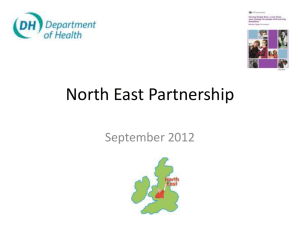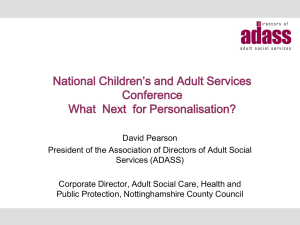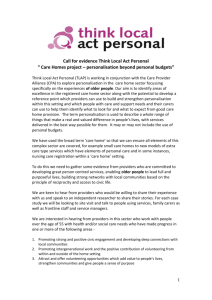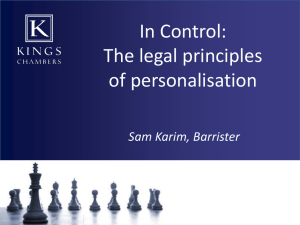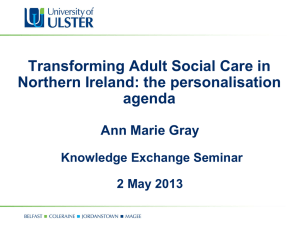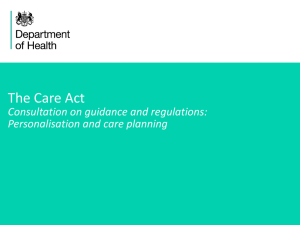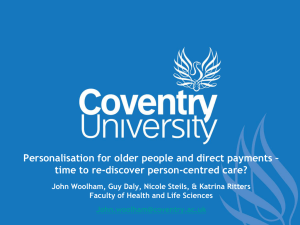Mental Health & Personalisation
advertisement
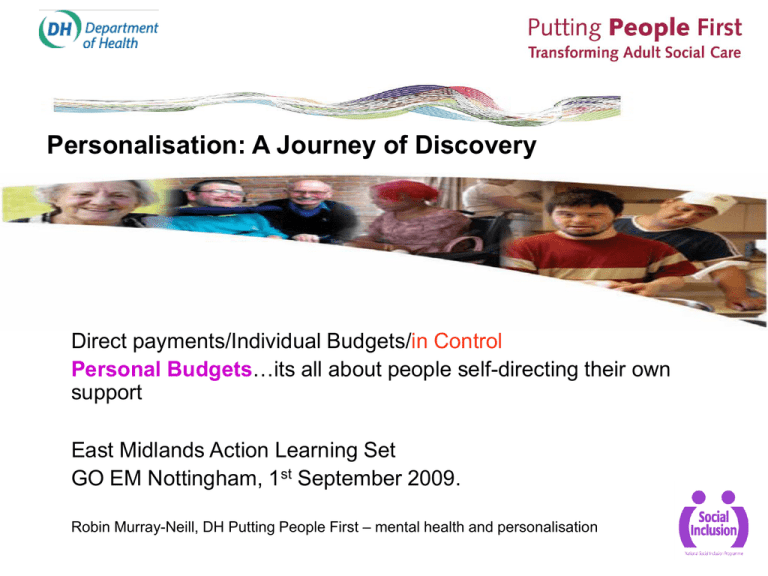
Personalisation: A Journey of Discovery Direct payments/Individual Budgets/in Control Personal Budgets…its all about people self-directing their own support East Midlands Action Learning Set GO EM Nottingham, 1st September 2009. Robin Murray-Neill, DH Putting People First – mental health and personalisation Paths to Personalisation 1 • A whole system, whole life framework for personalisation in mental health • Written by Anita Cameron from the National Development Team for Inclusion, in collaboration with an expert group of people who use mental health services, carers and others working on personalisation, inclusion and risk in mental health services • Meeting with National Mental Health Development Unit shortly to discuss hosting of Paths to Personalisation and mh-personalisation group Paths to Personalisation 2 • 10 sections (initially), derived from literature search and collaboration with expert group, looking at different aspects of what will make personalisation happen in mental health services • Each section starts with a statement from the perspective of a person using mental health services to “help focus attention on what needs to be in place to achieve the right outcomes for people, and on people’s real experiences of systems and services.” • These statements also provide a whole system quality checklist for personalisation • Each section provides links to relevant resources such as practical examples and published documents Paths to Personalisation 3 • “Personalisation? I know this is happening when I am treated with warmth, respect and honesty - when people listen to me, treat me as an equal, and support me – and when I don’t have to fight all the time to get what I want to help me recover and live my life the way I choose to” Mental health expert by experience. • A fundamental re-think of the relationship between citizens and public services runs through, for example, Improving the Life Chances of Disabled People, Our Health, Our Care, Our Say, Putting People First, and NHS Next Stage Review. Paths to Personalisation 4 • The main messages are very clear. We should expect a personalised approach, which means a relationship with public services which ensures that: – We are empowered to have more say and control in all aspects of public life and participate as active and equal citizens – We have maximum control of our own lives, including control of our own health and health care – We are supported to live independently, stay healthy and recover quickly – We have choice and control so that any support we may need fits the way we wish to live our lives Paths to Personalisation 5 • Helpful, person-centred systems and approaches – The systems I use support me to make my own decisions. People listen to me and treat me with respect • Information and advice, personal motivation and selfhelp – I have opportunities for self-help and taking control. I have the information and advice I need to feel empowered and make choices • Support for managing personal budgets – All the things are in place that can help me comfortably manage the resources allocated to me, in a way that suits me Paths to Personalisation 6 • Support for carers – I get the support I need to carry out my caring role, stay well and live my own life • Fair access and equality – Opportunities are available to me without discrimination or unfairness • Creative commissioning – There is opportunity, choice and innovation in what is available to support me and give me a good quality of life • Partnership for inclusion – My needs are met in a way that is easy for me. I get the support I need to participate as a citizen and take advantage of the things available to all Paths to Personalisation 7 • Prevention and early intervention – I get help and advice about how to stay well. Support and help are available to me and my family at an early stage if I begin to feel unwell or things go wrong • Good Leadership for all – I can have a leadership role and there is good leadership wherever it is needed • Workforce and organization development – The people who are paid to provide me with support and treatment have the right skills and approach and are available when I need them Paths to Personalisation 8 • I have a good experience when I first seek information, help or support.I am treated in a respectful way that leads to the right outcomes for me • People I come into contact with have the right approach and skills to treat me respectfully, help me recover and live my life the way I choose to • There is a planned and balanced approach to crisis and risk that I feel confident in and that does not undermine my sense of being in control of my life and recovery Paths to Personalisation 9 • Care Programme Approach and Assessment – – – – • 1. Wellness Recovery and Action Plan (add details) 2. 3 Keys to a Shared Approach in mental health assessment, CSIP/NIMHE, 2008 http://www.3keys.org.uk/ 3. Re-focusing the Care Programme Approach: Policy and Positive Practice Guidance , DH, March 2008 www.dh.gov.uk/publications 4. Effective Care Co-ordination in Mental Health services: Modernising the CPA: A policy booklet (DH, 2000) www.dh.gov.uk/publications Positive Risk Taking – – – – 5. DH, Independence, Choice and risk: a guide to best practice in supported decision making DOH, 2007 Best practice guide, learning and development materials, supported decision making tool, leaflet for people using services http://socialcare.csip.org.uk/index.cfm?pid=6 6. Person centred risk A course for senior managers, first line managers, family members and carers and support workers. http://www.helensandersonassociates.co.uk 7. Risk enablement and personalisation project. DH Social Inclusion Programme info@tonyryan.org 8. Positive Risk Taking Policy: Gateshead Council’s Community Based Services Paths to Personalisation 10 • Person-centred approaches – 10. Person-centred thinking with people who use mental health services, Helen Sanderson Associates with David Coyle, University of Chester (2005) www.helensandersonassociates.co.uk/PDFs/MHminibookweb.pdf – 11. Our choices in mental health, CSIP A framework for providers to extend choices andpractical support http://www.mhchoice.csip.org.uk – 12. Supporting People with Long Term Conditions (Re: Statement of values and principles of care planning. P12) http://www.dh.gov.uk/en/Publicationsandstatistics/Publications/PublicationsPolicy AndGuidance/DH_4100252 – 13. Co-production: an emerging evidence base for adult social care transformation: SCIE Research Briefing 31,2009 http://www.scie.org.uk/publications/briefings/briefing31/index.asp – 14. Website with support planning resources http://www.supportplanning.org/MentalHealth/ – 15. What are we learning about support planning? In development for the DH. Simon Stockton leading. (contact?) – 16. Person Centred Reviews and CPA, David Coyle Personalisation – some key characteristics • A new relationship between citizens and the publicly funded services they use • Public services working together around the individual rather than individuals navigating their way through a maze of publicly-funded services • People using resources in new ways so support fits into their life rather than their life being shaped by the support available • Focussing far more on what the person finds valuable and meaningful in life rather than on professionally defined objectives • It is about equality and social justice not pity SEU report 2004 • “Our vision is of a future where people with mental health problems have the same opportunities to work and participate in the community as any other citizen…” Social Exclusion Unit (2004) Mental Health and Social Exclusion: Social Exclusion Unit Report June 2004. London: Office of the Deputy Prime Minister “…This will mean: • • • • • • communities accepting that people with mental health problems are equal people receiving the support they need before they reach crisis point people having genuine choices and a real say about what they do and the support they receive in order to fulfil their potential people keeping their jobs longer and returning to employment faster, with real opportunities for career progression recognition of the fundamental importance of people’s relationships, family and caring responsibilities, a decent home, and participation in social and leisure activities; and health and social care services working in close partnership with employment and community services, with fair access regardless of ethnicity, gender, age or sexuality” Social Exclusion Unit (2004) Mental Health and Social Exclusion: Social Exclusion Unit Report June 2004. London: Office of the Deputy Prime Minister Where have we come from and where are we going to? [A personal view of changes in prevailing themes!] Segregated institutional care Community based care and support Medically based approach Duality of ‘health’ and ‘social’ care Individualised/ Socially personalised based support approach Lunatics, cripples, idiots Clients and service users Cure Doctor knows best Care Professional intervention Citizens with equal rights and opportunities Independent Living Recovery SDS Individual knows best: Coproduction Vivien Lindow • “The idea that those who oppose current methods of psychiatric “treatment” do not acknowledge the need for services is strange and fantastic to most of us whose experiences have led us to traditional psychiatry. What is different is the existence of choice and freedom in meeting our needs.” Lindow, V. (1994) Self-help alternatives to mental health services. London: MIND Recovery What does ‘recovery’ mean for an individual? • “a process of changing one’s orientation and behaviour from a negative focus on a troubling event, condition or circumstance to the positive restoration, rebuilding, reclaiming or taking control of one’s life.” NIMHE Guiding Statement on Recovery (January 2005) Recovery What does recovery mean for a system designed to provide support to people? • • • • Focus on people rather than services. Monitoring outcomes rather than performance. Emphasising what people can do rather than what they can’t do. Educating people who provide services, schools, employers, the media and the public to combat stigma. • Collaboration between those who need support and those who support them as an alternative to coercion. • Enabling and supporting self-management, promoting autonomy and, as a result, decreasing the need for people to rely on formal services and professional supports. NIMHE Guiding Statement on Recovery (January 2005) What are we trying to achieve? ‘…a new direction for care services’ A new relationship between citizens and their public servants A shift from crisis intervention towards enablement and early intervention to promote independence Support and services which can be available to people when they need them, not when they have fulfilled service criteria Personalisation – 4 elements Community facilities and services that we all use, e.g. transport, leisure, health, education, housing and access to information and advice People as participants in their communities, friendships and family relationships. Individuals with lives and relationships. Support that’s available for people to stay independent for as long as possible, people choosing who provides their support and what form that support takes, and controllling when and where those services are provided, rather than being expected to fit in with what’s already on offer. A clear goal! “This landmark protocol seeks to set out and support the Government’s commitment to independent living for all adults.” HM Government (2007) Putting People First: A shared vision and commitment to the transformation of Adult Social Care. Independent Living “Independent Living is about the Empowerment of disabled people and their ability to control their own lives. It is not the name of a particular service or provision but should be the objective of services and provisions and the furtherance of Disabled People’s human and civil rights... a concept that is relevant to all disabled people, whatever their impairment/s…the whole range of practical solutions to disabled peoples’ inclusion in mainstream society” (Coventry Independent Living Group in Barnes et. al., 1996:10) A basic principle “Everyone, irrespective of their illness or disability has the right to self determination and maximum control over their own lives." Alan Johnson, Health Secretary, December 10th, 2007 ‘Outcomes’ rather than ‘Activity’: concerning ourselves more with the right result than with the ‘right’ way of getting to it! “As a general principle, local councils should aim to leave choice in the hands of the individual by allowing people to address their own needs as they consider best, whilst satisfying themselves that the agreed outcomes are being achieved.” Direct Payments Guidance: Community Care, Services for Carers and Children’s Services (Direct Payments) Guidance England 2003 Department of Health Direct payments have shown how differently people might do things Buying a dog Purchase of a mobile phone Driving lessons Playing in a violin group Joining a fishing club Renting a workshop (two people together) Hiring an art teacher (four people together) Employing someone to manage a small enterprise (six people together) Participating and running an independent leisure, sport and social group (twenty people together) Paying for travelling to stay with relative for a break Understanding the different terms used Independent living [The Purpose/Goal] Personalisation [The Policy Direction/Approach] Self-directed support/Right to Control [The System] Individual budgets [combining funding sources] Personal budget [single funding source] Provided Services (ISF/Spot/Block contracting) Direct payments Independent Living/Recovery (Citizenship/Inclusion) Self-directed support/Right to Control: a new system to make Individual/Personal Budgets work Cash (direct payments) Support requested from a provider Direct Payments • The mechanism that enables public authorities to pay money to people as a means of them accessing the support they require – A duty on local councils in most cases where a person is eligible to receive social care support – It is intended that a permission will be established for PCTs in respect of people involved in the piloting of Personal Health Budgets – The piloting of the right to control for disabled people from 2010 will introduce direct payments for Acces to Work; Independent Living Funds; Specialist Employment Programmes; and other areas to be determined by consultation Individual Budgets • “Helping disabled people to achieve independent living by moving progressively to individual budgets for disabled people, drawing together the services to which they are entitled and giving them greater choice over the mix of support they receive in the form of cash and/or direct provision of services.” Prime Minister’s Strategy Unit, DWP, DH, DfES, ODPM (2005) Improving the Life Chances of Disabled People – January London: Cabinet Office Personal Budget • The amount of money that a person is entitled to use to meet their needs for social care support • This may be one element in a larger Individual Budget • For most people it may be: – taken entirely as a direct payment, – spent entirely on the person’s behalf by the local authority or other nominated body, or – any mixture of the two. Individual/Personal Budgets • Require a system which promotes the flexibility intended by the introduction of direct payments irrespective of whether a person chooses to receive a direct payment or not: – People are clear how much money they have to spend – The focus shifts from what services should be provided towards enabling people to utilise their resources to achieve the best result for them in a way that suits them – The system is based on equal rights and equality of access to opportunities and activities rather than traditional notions of ‘caring for those less fortunate’ and ‘helping people make the best of their lot in life’, etc…… Self directed support – key steps… Direct payments 1997 dp up 2007 www.directpayments.csip.org.uk www.ncil.org.uk www.in-control.org.uk in Control 2003 www.Individualbudgets.csip.org.uk www.personalisation.org.uk Individual Budget pilots 2006 Self-directed support 7. Seeing how it’s worke d 1. My money Finding out how much 6. Living my life 2. Making my plan 5. Organising my support 3. Getting my plan agreed 4. Organising my money About the Individual Budget Pilot Programme •13 Local Authorities •Ran for 2 years – finished December 2007 •Was fully evaluated – report anticipated later in 2008 •All adults •Drew heavily on learning from In Control, and from direct payments implementation What did the pilots find out? • IBs were typically used to purchase personal care, assistance with domestic chores, and social, leisure and educational activities; • People receiving an IB were more likely to feel in control of their daily lives, compared with those receiving conventional social care support; satisfaction was highest among mental health service users and physically disabled people and lowest among older people; • Little difference was found between the average cost of an IB and the costs of conventional social care support, although there were variations between user groups Specific issues for mental health • Mental health service users reported: – the poorest overall quality of life, – poorer psychological wellbeing, – were more likely to fall into the at-risk category for psychological ill health. – greater current social care needs than other groups • A low availability of appropriate support for IB users with mental health problems • Some staff felt they were not clear about what was going on, some were reported to have paternalistic and protective attitudes • A number of sites had experience of people with mental health problems under-assessing their own needs • Glendenning et.al. (2008) Evaluation of the Individual Budgets Pilot Programme: Final Report. York: IBSEN c/o Social Policy Research Unit, University of York “better outcomes at roughly an equivalent cost” • Cost-effectiveness evidence in support of IBs is strongest for mental health service users, on both Social care and psychological wellbeing outcome measures. Actual costs were very similar (£149pw IB; £152pw comparison group) • A number of sites had experience of older people, and people with mental health problems in particular, under-assessing their own needs • the costs of care management of people with mental health problems and learning disabilities from earlier research are very similar to the reported costs of the IB group A different way of managing resources… • people with a mental health problem (71 per cent) or a physical disability (69 per cent) were significantly more likely to opt for the choice of having their IBs transferred into their personal bank account Non-statutory organisations can play a key role in helping to make personal budgets work Information about personal budgets Support to think about how to use a personal budget Support with self-assessment Advocacy Providing support to plan and/or manage a personal budget Acting as an agency employer of staff Offering services for people to buy with their personal budgets Self directed support – more key steps… Personal Budgets 2007 www.in-control.org.uk www.personalisation.org.uk Staying in Control 2008 Personal Health Budget pilots personalhealthbudgets@dh.gsi.gov.uk 2009 Staying “The challenge is to develop a coherent model of Self Direction that works across health and social care, respecting difference in legislation and character of interventions and expertise.” At home - with no significant use of community or social care services. In hospital - receiving planned or unplanned health care, including mental health care. Using intermediate care - receiving therapies or support to help a return to home. At home with support - at home but needing on-going support to maximise health and well-being. Personal Health Budgets • “…in 2009, we will start piloting personal health budgets, as a way of giving patients greater control over the services they receive and the providers from which they receive services.” • “those with long term conditions, those receiving NHS Continuing Healthcare and users of mental health services might be well placed to benefit.” DH (2008) Personal Health Budgets Initial information sheet Changing Attitudes: The way to social inclusion Individual Dependent and Vulnerable Choice and Control Service Providing and Protecting Facilitation and Support Community Segregation and Stigma Engagement and Participation Some useful resources Heslop, P., (2001/2007) Direct Payments for Mental Health Service Users/Survivors: A guide to some key issues London: National Centre for Independent Living Available from: www.ncil.org.uk Breaking Barriers (Video/DVD, 2003) Equalities: The National Council for Disabled People and Carers from Black and Minority Ethnic Communities equalities@equalitiesnational.org.uk Available from: kevin.whiteley@csip.org.uk Brewis, R. (2007) A Voice and A Choice: self-directed support by people with mental health needs, a discussion paper in Control www.in-control.org.uk Direct payments and mental health (DVD, 2007) CSIP NEYH Development Centre/Rotherham Metropolitan Borough Council Available from: kevin.whiteley@csip.org.uk DH Putting People First – mental health and personalisation Robin Murray-Neill Eastern Development Centre, 654 The Crescent, Colchester Business Park, COLCHESTER, Essex. CO4 9YQ 01206 287588 07747 536067 robin.murray-neill@dhsocialcareprogrammes.org.uk
